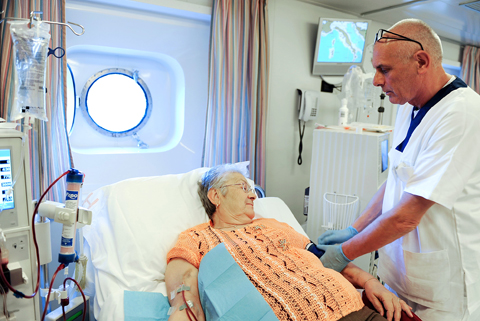Sailing the Mediterranean, exploring the fjords of Norway or visiting fabled sites of ancient civilizations — these are dream vacations that can shatter when kidney disease strikes.
“The day the doctor told me I would need dialysis, I thought I wouldn’t be able to travel any more,” said Josette Georgin, 72, from the French city of Metz. “To have dialysis, it’s like being in a prison without bars.”
Then she discovered dialysis cruising.

PHOTO: AFP
Dialysis cruises, organized by the Gerard Pons Voyages travel agency in Bordeaux in partnership with the luxury line Costa Cruises, offers 15 trips a year with an onboard fully-equipped dialysis clinic, providing rare mobility and precious freedom for the ever-growing population of dialysis patients.
The UK Renal Registry said more than 20,000 patients receive dialysis every year in Britain.
The figures are slightly higher in France and Italy. Across the world, as people live longer, the number of dialysis patients increases by 8 percent a year.
The average age for starting dialysis is 65, just when many retirees begin traveling. But there are also many younger people on dialysis who will never know the freedom of travel.
One family took their 16-year-old on dialysis for a dream family vacation. A young couple, the husband on dialysis, celebrated their honeymoon and another couple feted their five-year wedding anniversary.
The nature of the disease makes travel potentially dangerous. People undergo dialysis when their kidneys fail and cannot purify their blood. Functioning kidneys purify blood every day, all day long.
A patient typically undergoes dialysis three times per week, each session lasting several hours. Without dialysis, they will die.
Should the patient travel, the logistics of arranging for dialysis in a different hospital, let alone a foreign country, are daunting enough to keep them at home. To travel, they need complete faith in the people overseeing their logistics and healthcare.
Gerard Pons, the industry leader in dialysis cruises, and Anne-Caroline Leurent, his dialysis cruise expert, inspire such confidence.
Pons came up with the idea of onboard dialysis more than 20 years ago while talking to a friend who was a nephrologist. On the one hand, he wanted to offer luxury travel, and on the other he needed an irreproachable dialysis service.
Costa Cruises offers some of the most popular itineraries in the industry — and three ships that have onboard hospitals spacious enough to host a temporary dialysis clinic.
The clinics are managed by Fresenius, known for manufacturing dialysis units, operating dialysis centers and coordinating dialysis sessions for travelers. Fresenius supplies top-of-the-line equipment and a medical team, including a nephrologist and three nurses. There are four dialysis units on each cruise, allowing for 12 patients.
Despite the economic crisis, Leurent reported that places are fully booked on cruises scheduled for the first half of this year. She has had one cancellation from a Briton whose bank crashed, but someone on the wait list quickly snapped up his spot.
The lure of secure medical care in the morning followed by a jaunt to Mount Vesuvius in the afternoon keeps demand high.
“When I’m onboard, it’s very luxurious,” said Georgin, who has already taken all of the offered cruises and plans more. “I forget that I have dialysis. I am on vacation and the dialysis is only a small part of the trip, four hours, three times per week.”
Extra care is taken to schedule the treatment around excursions, and the onboard crew also takes care to integrate the dialysis patients into the regular crowd.
“Onboard, no one knows I’m dialyzed, apart from the medical staff,” Georgin said.
This is important as vacations provide an escape from daily life and these cruises allow dialysis patients to enjoy a holiday like everyone else. Health insurance is naturally an issue. The final cost to the customer for onboard dialysis depends on their national health service.
For the French, the cost normally falls within the limits covered by the French national health service, making it no more costly to dialyze on a cruise ship headed to Helsinki than back at home in Lyon.
For British customers, the National Health Service does not always cover the cost of private care dialysis and each hospital has its own policy.
When Pons saw that 30 percent of his dialysis clients came from Britain, he formed a partnership with Lisa Parnell, owner of Dialysis Holidays in Boston, England.
Parnell began her business after working for several years in a hospital haemodialysis unit.
“It’s really nice to make dreams come true for people who have a medical condition,” she said.
Travel insurance presents another challenge.
Dialysis patients have a pre-existing disease so are not covered by regular travel insurance policies. Pons overcomes this obstacle by offering a policy that covers dialysis travelers and their families and costs just 20 euros (US$27) more than a regular policy.
Meeting the needs of his special clients has paid off for Pons. The niche market generates 800,000 euros (US$1 million) for his 6.5 million-euro travel agency.
With Fresenius scheduled to open a dialysis clinic in Dubai, Pons hopes to offer a dialysis cruise to the United Arab Emirates next year.
What is the reaction from their clients?
“They’re excited,” Leurent said. “They want to go to new places.”

Taiwan is projected to lose a working-age population of about 6.67 million people in two waves of retirement in the coming years, as the nation confronts accelerating demographic decline and a shortage of younger workers to take their place, the Ministry of the Interior said. Taiwan experienced its largest baby boom between 1958 and 1966, when the population grew by 3.78 million, followed by a second surge of 2.89 million between 1976 and 1982, ministry data showed. In 2023, the first of those baby boom generations — those born in the late 1950s and early 1960s — began to enter retirement, triggering

ECONOMIC BOOST: Should the more than 23 million people eligible for the NT$10,000 handouts spend them the same way as in 2023, GDP could rise 0.5 percent, an official said Universal cash handouts of NT$10,000 (US$330) are to be disbursed late next month at the earliest — including to permanent residents and foreign residents married to Taiwanese — pending legislative approval, the Ministry of Finance said yesterday. The Executive Yuan yesterday approved the Special Act for Strengthening Economic, Social and National Security Resilience in Response to International Circumstances (因應國際情勢強化經濟社會及民生國安韌性特別條例). The NT$550 billion special budget includes NT$236 billion for the cash handouts, plus an additional NT$20 billion set aside as reserve funds, expected to be used to support industries. Handouts might begin one month after the bill is promulgated and would be completed within

NO CHANGE: The TRA makes clear that the US does not consider the status of Taiwan to have been determined by WWII-era documents, a former AIT deputy director said The American Institute in Taiwan’s (AIT) comments that World War-II era documents do not determine Taiwan’s political status accurately conveyed the US’ stance, the US Department of State said. An AIT spokesperson on Saturday said that a Chinese official mischaracterized World War II-era documents as stating that Taiwan was ceded to the China. The remarks from the US’ de facto embassy in Taiwan drew criticism from the Ma Ying-jeou Foundation, whose director said the comments put Taiwan in danger. The Chinese-language United Daily News yesterday reported that a US State Department spokesperson confirmed the AIT’s position. They added that the US would continue to

IMPORTANT BACKER: China seeks to expel US influence from the Indo-Pacific region and supplant Washington as the global leader, MAC Minister Chiu Chui-cheng said China is preparing for war to seize Taiwan, Mainland Affairs Council (MAC) Minister Chiu Chui-cheng (邱垂正) said in Washington on Friday, warning that Taiwan’s fall would trigger a regional “domino effect” endangering US security. In a speech titled “Maintaining the Peaceful and Stable Status Quo Across the Taiwan Strait is in Line with the Shared Interests of Taiwan and the United States,” Chiu said Taiwan’s strategic importance is “closely tied” to US interests. Geopolitically, Taiwan sits in a “core position” in the first island chain — an arc stretching from Japan, through Taiwan and the Philippines, to Borneo, which is shared by